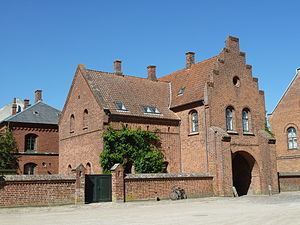Location Sorø Opened 1201 | Year consecrated 1142 Completed 1201 (1201) Groundbreaking 1142 | |
 | ||
Burials Absalon, Olaf II of Denmark, Euphemia of Pomerania, Eric Christoffersen of Denmark, Olaf (II) Haraldsen Similar Sorø Klosterkirke, Bjernede Church, Antvorskov, Pedersborg kirke, Esrum Abbey | ||
Sorø Abbey was the preeminent and wealthiest monastic house in all of Denmark during the Middle Ages. It was located in the town of Sorø in central Zealand.
Contents
History
Sorø was founded by Asser Rig, the son of Skjalm Hvide, Zealand's most powerful noble in 1142. Asser established a Benedictine House just a few years prior to his death in 1151. He then lived as a monk for the last years of his life. It was common practice for wealthy and powerful individuals and families to found a religious house for several reasons: expiation of a sinful life, commemorative masses for family members, help for the poor, or out of religious zeal or devotion. Asser Rig's son, Absalon, became the powerful warrior bishop of Zealand and advisor to several Danish kings. In a move to reform Sorø, Bishop Absalon supplanted with Cistercian monks from Esrum Abbey in 1161. One of Absalon's friends Peder Strang endowed the abbey with enough land to make it financially solvent from that time on.
The Cistercians went to work on building the abbey church and monastery using a new building material, large,red bricks. The technology and style had been imported from northern Germany.
From that time forward Sorø acquired property all over Denmark with an income larger than that of the royal family.
The abbey church became the burial place of the noble Hvide family. Absalon was buried behind the main altar. Three Danish kings are buried there: Christopher II, Valdemar IV Atterdag, and Oluf II. Margaret I was buried there and later moved to Roskilde Cathedral. The church remains an excellent example of early brick Gothic architecture.
Saxo Grammaticus wrote one of Denmark's most important historical sources Gesta Danorum at Sorø Abbey. Saxo the Tall (Danish:Lange), as he was called at Sorø, wrote a sixteen volume chronicle of Danish history for Bishop Absalon. Only later was he called "Grammaticus" as a result of his excellently written Latin. Saxo's work was completed before 1208.
In 1247 much of the abbey burned down and remained in ruins for about ten years. A gift from Widow Ingeborg Strangessen allowed the rebuilding of the abbey with arched vaults.
Reformation in Denmark
Denmark became officially Lutheran in 1536 and the process of eliminating Catholic institutions and practice were carried out over the next decades. Sorø Abbey was turned into a home for monks who had no place else to go. It became crown property in 1580. In 1584 the monastery buildings came into the possession of Peter Reetz, a member of the State Council and Soro was set up for two sons of Frederik II, Christian, later Christian IV and Prince Ulrich. Two years later an academy had been established for the sons of wealthy noble families. Between 1596 and 1600 Christian IV built one of Denmark's first tennis courts at the academy. It was later transformed in the library at the Academy. Sorø Academy continued on and off again until the present day.
